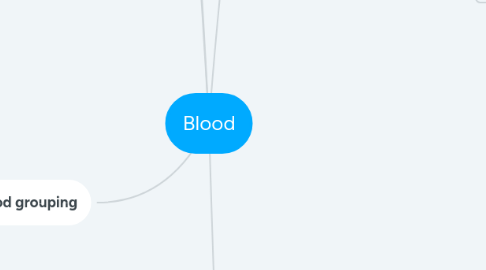
1. Volume
1.1. 5-5.5 litres
2. Blood grouping
2.1. Antigen
2.1.1. Foreign substances which triggers immune system
2.2. Antibodies
2.2.1. Kills antigens
2.2.1.1. Exception
2.2.1.1.1. Self antigens can't be killed by their antibodies
2.2.2. Secreted by lymphocytes
2.3. Landsteiner's law
2.3.1. Proposed by Karl Landsteiner
2.3.2. "If an antigen is present on RBCs then corresponding antibody must be absent from plasma"
2.3.3. Reported ABO blood groups for the first time
2.3.4. Location of antigen
2.3.4.1. RBC
2.3.5. Location of antibody
2.3.5.1. Plasma
2.3.6. Agglutinogens
2.3.6.1. "Antigens on the surface of RBC"
2.4. Donor compatibility
2.4.1. A blood group
2.4.1.1. Antigen: A
2.4.1.2. Antibody: Anti-B
2.4.1.3. Donor: A,O
2.4.2. B blood group
2.4.2.1. Antigen: B
2.4.2.2. Antibody: Anti-A
2.4.2.3. Donor: B,O
2.4.3. AB blood group
2.4.3.1. Antigen: AB
2.4.3.2. Antibody: None
2.4.3.3. Donor: A,B,AB,O
2.4.3.4. Universal recepient
2.4.4. O blood group
2.4.4.1. Antigen: None
2.4.4.2. Antibody: Anti-A,B
2.4.4.3. Donor: O
2.4.4.4. Universal donor
2.5. Rhesus factor
2.5.1. Discovered by Landsteiner and Weiner
2.5.2. RBCs having antigen: Rh+ve
2.5.3. RBCs having no antigen: Rh-ve
2.5.4. Rh incompatibility
2.5.4.1. Mother: Rh-ve
2.5.4.2. Fetus: Rh+ve
2.5.4.3. After delivery
2.5.4.3.1. Rh+ve from fetus may enter mother
2.5.4.3.2. Mother produces anti Rh+ bodies
2.5.4.3.3. Anti Rh+ bodies leaks via placenta
2.5.4.3.4. Anti Rh+ bodies reach the baby
2.5.4.3.5. Rh+ of the baby and Anti Rh+ bodies causes severe complications in the baby
2.5.4.3.6. HDN in newborn
2.5.4.4. How to prevent HDN in newborn?
2.5.4.4.1. After 1st pregnancy
2.5.4.4.2. Solution RhoGAM vaccine is given to mother
2.5.4.4.3. This vaccine inactivates fetal antigen
2.5.4.4.4. Hence, no complications will be seen in the baby
2.6. Bombay blood group
2.6.1. Rare
2.6.2. Antigen A or B is not seen
3. Clotting factors
3.1. Fibrinogen
3.2. Prothrombin
3.3. Thromboplastin
3.4. Calcium
3.5. Labile factor
3.6. Stable factor
3.7. Anti-hemophilic factor A
3.8. Christmas factor
3.9. Stuart prower factor
3.10. Plasma Thromboplastin Antecedent
3.11. Hageman factor
3.12. Fibrin stabilising factor
4. Composition
4.1. Plasma (55%)
4.1.1. Characteristics
4.1.1.1. Alkaline
4.1.1.2. Non-living
4.1.1.3. Intercellular substance
4.1.1.4. Pale yellowish fluid (transparent)
4.1.2. Composition
4.1.2.1. Water (90-92%)
4.1.2.2. Proteins (6-8%)
4.1.2.2.1. Fibrinogen
4.1.2.2.2. Globulins
4.1.2.2.3. Albumins
4.1.2.3. Minerals (<1%)
4.1.2.4. Other substances (<1%)
4.1.2.4.1. Nutrients
4.1.2.4.2. Gases
4.1.2.4.3. Waste
4.1.2.4.4. Hormones
4.1.2.4.5. Vitamins
4.1.2.4.6. Anticoagulant: Heparin
4.1.2.5. Serum (Plasma - clotting proteins)
4.2. Formed elements (45%)
4.2.1. Blood cells
4.2.1.1. Erythrocytes
4.2.1.1.1. RBC
4.2.1.1.2. Abundant (5-5.5 million RBC per m^3 of blood)
4.2.1.1.3. Males: More RBC
4.2.1.1.4. Females: Less RBC
4.2.1.1.5. Shape
4.2.1.1.6. Enucleate
4.2.1.1.7. Lack cell organelles
4.2.1.1.8. Has hemoglobin
4.2.1.1.9. Life span
4.2.1.1.10. Site of production
4.2.1.1.11. Formation
4.2.1.1.12. Graveyard
4.2.1.1.13. Cases
4.2.1.1.14. Functions
4.2.1.1.15. ESR
4.2.1.1.16. Rouleaux
4.2.1.2. Leucocytes
4.2.1.2.1. Characteristics
4.2.1.2.2. Composition
4.2.2. Blood platelets
4.2.2.1. Thrombocytes
4.2.2.2. Cell fragments formed from megakaryocyte
4.2.2.3. 1,50,000-3,50,000 per m^3 of blood
4.2.2.4. Formation
4.2.2.4.1. Thrombopoeisis
4.2.2.5. Cases
4.2.2.5.1. If blood platelets increase
4.2.2.5.2. If blood platelets decrease
4.2.2.6. Lifespan
4.2.2.6.1. 1 week
4.2.2.7. Graveyard
4.2.2.7.1. Spleen
4.2.2.7.2. Liver
4.2.2.8. Release platelet factors (thromboplastin)
4.2.2.9. Important for blood clotting
5. Haemostasis
5.1. Vascular spasm
5.1.1. Shrinkage of diameter of blood vessel
5.2. Platelet plug formation
5.2.1. Platelet adhesion
5.2.1.1. Platelet reaches the site of damage and attach
5.2.2. Platelet release action
5.2.2.1. Platelet gets activated
5.2.2.2. Releases ADP + Thromboxane A2
5.2.3. Platelet aggregation
5.2.3.1. Group of platelets cover the damaged part
5.3. Blood clotting
5.3.1. Series of chemical reaction which results in formation of fibrin threads
5.3.2. Extrinsic pathway
5.3.2.1. Rapid process
5.3.2.2. Simple process
5.3.2.3. Due to tissue trauma
5.3.2.4. Releases tissue plastin or tissue factor
5.3.2.5. In the presence of Ca2+
5.3.2.6. Turns into Activated X
5.3.2.7. In the presence of Ca2+
5.3.2.8. Turns into Prothombrokinase
5.3.3. Intrinsic pathway
5.3.3.1. Slow process
5.3.3.2. Complex process
5.3.3.3. Due to blood trauma
5.3.3.4. Results in damage to endothelial cells
5.3.3.5. Expose collagen fibres
5.3.3.6. Results in damage to platelets
5.3.3.7. In the presence of Ca2+
5.3.3.8. Turns into Activated X
5.3.3.9. In the presence of Ca2+
5.3.3.10. Turns into Prothombrokinase
5.3.4. Formation of Thrombin
5.3.4.1. Prothrombin ---> Thrombin
5.3.4.2. Occurs in the presence of thrombrokinase and Ca2+
5.3.5. Formation of Fibrin
5.3.5.1. Fibrinogen --> Fibrin
5.3.5.2. Occurs in the presence of thrombin
5.3.5.3. Fibrinogen is soluble
5.3.5.4. Fibrin is insoluble
5.3.5.5. Fibrin forms a mesh and stops blood flow
5.3.5.6. Thus, formed a blood clot (by entangling with fibres)
5.3.6. Clot retraction
5.3.6.1. Consolidation of tightening of fibrin clot
5.4. Prevents haemorrhage
5.5. Role of vitamin K
5.5.1. Necessary for synthesis of prothrombin
5.5.2. If there is less absorption of lipids
5.5.3. It results in less vitamin K production
5.5.4. Results in less prothrombin formation
5.5.5. Results in uncontrollable bleeding
5.6. Role of Ca2+ ions
5.6.1. Necessary for most steps of coagulation
5.6.2. Without enough calcium, blood won't clot properly
